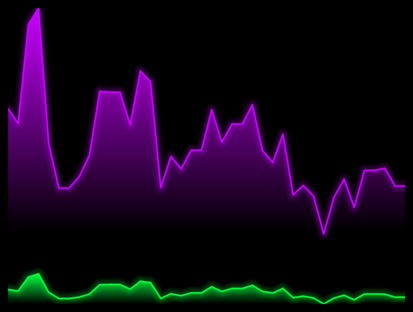A Python package on top of matplotlib to create 'cyberpunk' style plots with 3 additional lines of code.
pip install mplcyberpunk
After importing the package, the cyberpunk stylesheet (dark background etc.) is available via plt.style.use.
The line glow and 'underglow' effects are added via calling add_glow_effects:
import matplotlib.pyplot as plt
import mplcyberpunk
plt.style.use("cyberpunk")
plt.plot([1, 3, 9, 5, 2, 1, 1], marker='o')
plt.plot([4, 5, 5, 7, 9, 8, 6], marker='o')
mplcyberpunk.add_glow_effects()
plt.show()Result:
This effect is currently only implemented for lines.
The individual steps are described here in more detail.
Instead of add_glow_effects, you can add the line glow and underglow effects separately:
mplcyberpunk.make_lines_glow()
mplcyberpunk.add_underglow()
You can also add the effect to a specific axis object explicitly:
fig, ax = plt.subplots()
...
mplcyberpunk.make_lines_glow(ax)
To activate the glow effect only for specific lines, pass a Line2D object or a list of Line2Ds to make_lines_glow.
Gradient underglow effect can be added with
mplcyberpunk.add_glow_effects(gradient_fill=True)
or independently of line glow with
mplcyberpunk.add_gradient_fill(alpha_gradientglow=0.5)
add_gradient_fill takes a gradient_start argument for different gradient starting values:
Glow effect can be added to scatter plots via mplcyberpunk.make_scatter_glow():
The default colormap is cool:
Others:
Some images can be bought as posters here.
Depends only on matplotlib.












